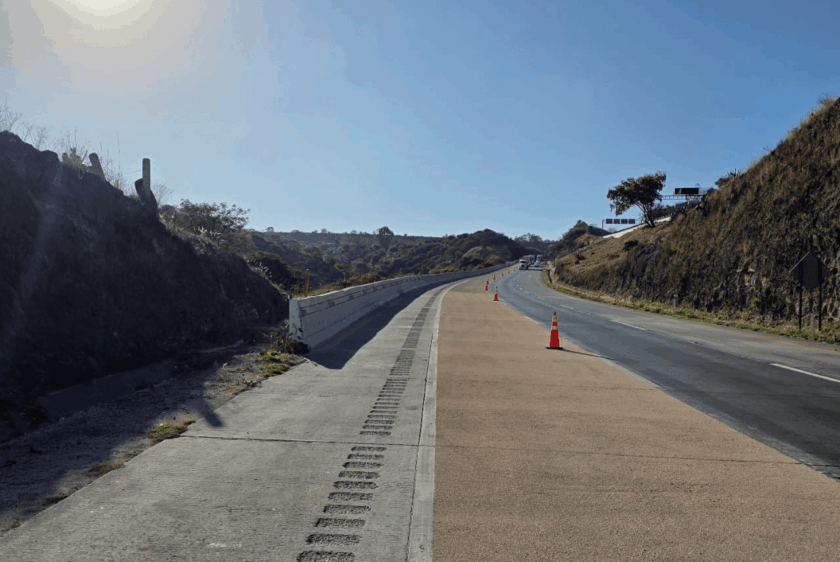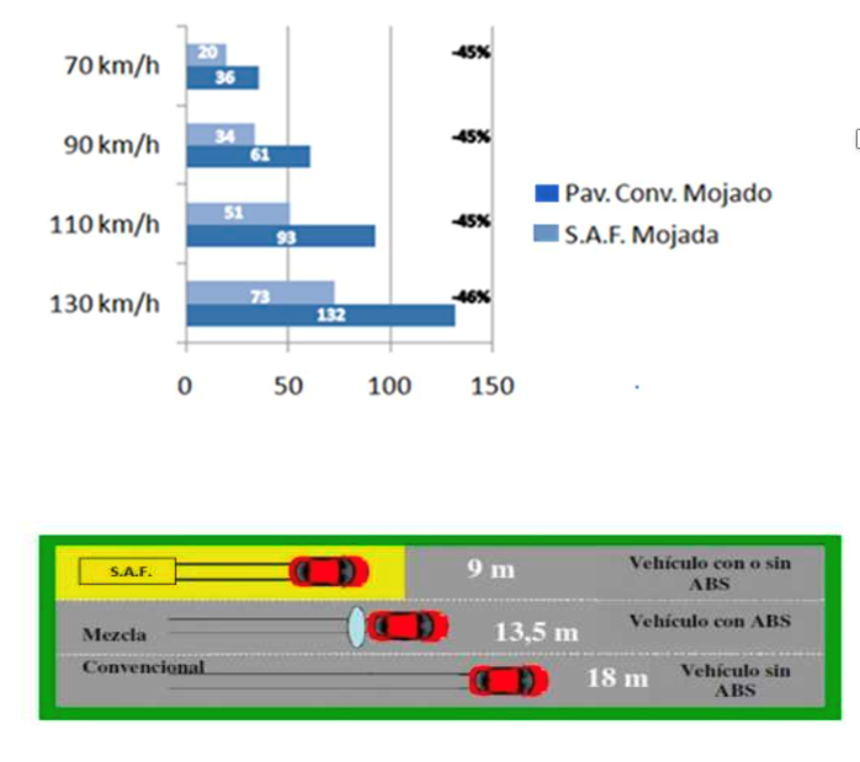
ROCBINDA® is a high-friction surface that provides safety and reduces the accident rate, especially on dangerous curves, steep slopes, approaches to toll booths, among other high-accident areas on roads.
This system is composed of a two-component, highly durable polyurethane resin, which acts as a binding agent; calcined bauxite is then added, which acts as a friction material.
ROCBINDA® is the high friction system with the greatest international recognition due to its high performance and durability and one of the few products available with theBBA HAPAS certification for use on roads, on asphalt and hydraulic concrete pavements with a durability of 5 to 10 years.
On July 7, 2025, the General Directorate of Technical Services of the Ministry of Infrastructure, Communications and Transportation certified ROCBINDA® as a new technology under the following terms:
“… This General Directorate of Technical Services considers that the ROCBINDA system may be a viable alternative to surface treatments used in road maintenance […] particularly useful for reducing loss-of-control accidents on wet and dry pavement in critical locations such as horizontal curves and in acceleration and deceleration zones…”
The main benefit of ROCBINDA® lies in its ability to significantly reduce braking distance, especially in rainy conditions. This allows for more stable and controlled braking, reducing the risk of skidding and collisions.
The implementation of high-friction surfaces like ROCBINDA® directly contributes to reducing accidents in critical areas. This translates into the protection of human lives and a reduction in serious injuries resulting from road accidents.
From a budgetary perspective, ROCBINDA® represents an efficient investment for road infrastructure managers. Its use allows for:
• Reducing costs associated with accidents (medical care, property damage, litigation, etc.).
• Reducing the frequency of road surface interventions.
• Enabling downward adjustments to insurance policies, thanks to improved safety indicators.
• Extending the useful life of the asphalt or concrete surface where it is applied, reducing maintenance costs.

From multiple field studies carried out to verify the effectiveness of ROCBINDA® in reducing braking distance, it was concluded that this High Friction System can reduce braking distance by up to 60 meters in wet conditions, as shown in the graphs shown below.
The use of ROCBINDA is highly recommended for so-called “blackheads”
ROCBINDA® uses a two-component polyurethane resin as a binding agent; however, in Mexico, there are products that use epoxy resin instead.
As can be seen in the table below, there is a clear difference and advantage in the application of High Friction Surfaces using polyurethane resins, especially due to their quality and durability:
| POLYURETHANE | EPOXY | |
|---|---|---|
| Flexibility and impact resistance |
Greater flexibility. Allows you to better absorb vibrations, impacts, and movements. |
Menor flexibilidad |
| Thermal changes |
Greater elongation capacity and better tolerance to temperature changes. Allows them to maintain adhesion under variable thermal conditions |
Menor capacidad de elongación y tolerancia a cambios de temperatura |
| Moisture resistance | Greater resistance | Lower resistance |
| Material compatibility | Better adhesion on different surfaces | Lower adhesion on special surfaces |
| Adaptability to pavement deformations | Being more flexible and elastic, it accompanies pavement deformations, reducing the risk of failure at the adhesive interface. | They tend to fail by fracture or delamination when the substrate (the pavement) expands or contracts with thermal changes or due to dynamic loading. |
| Behavior under dynamic load | Due to its viscoelastic behavior, it distributes stresses better and better withstands the impact of bauxite over the long term. | Its stiffness can be a disadvantage on pavements subjected to cyclic loading or heavy traffic, as it can crack or peel. |

According to the United Nations, the cost of accidents represents approximately 1.4% of the country's gross domestic product.

Likewise, vehicle accidents are estimated to be the leading cause of death among children aged 5 to 14 and young adults aged 15 to 29, and injuries from accidents of this nature are considered the eighth leading cause of death worldwide.

In 2022, the Mexican Institute of Transportation (IMT) reported losses of 2.024 billion pesos due to traffic accidents on Mexico's federal highways.
The implementation of high-friction surfaces (HFS) has proven to be an effective measure in reducing road accidents, especially in high-risk areas such as sharp curves, slopes, and intersection access points.
It has been reported that applying SAF on horizontal curves can reduce road departures by up to 75% in wet pavement conditions.
The Federal Highway Administration (FHWA) reports that applying SAF can reduce wet crashes by up to 83% and total crashes by 57% in high-friction areas.
Studies indicate that high-friction surfaces reduce skidding accidents by 60% to 70%, and total accidents by 50%.
At sites treated with SAF, a 39% reduction in total accidents and up to 95% reduction in accidents due to loss of control on curves will be observed.